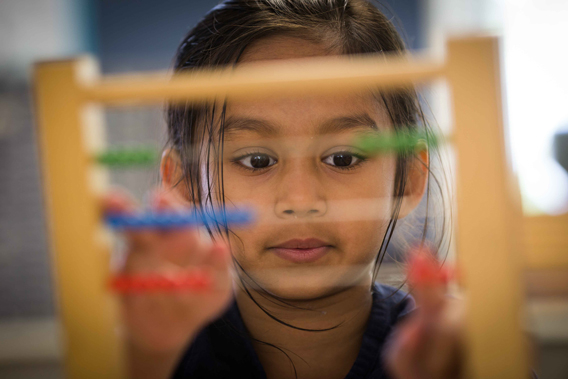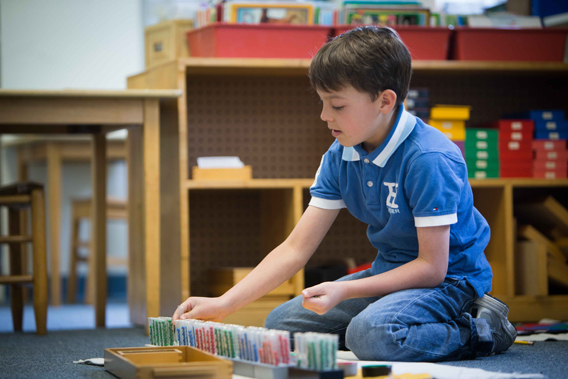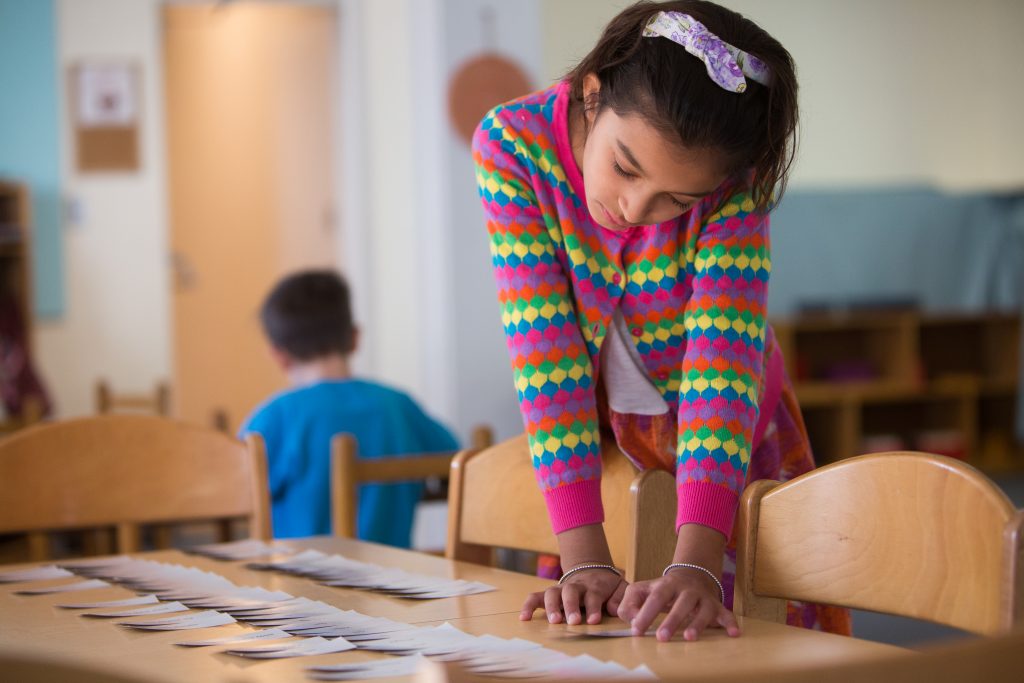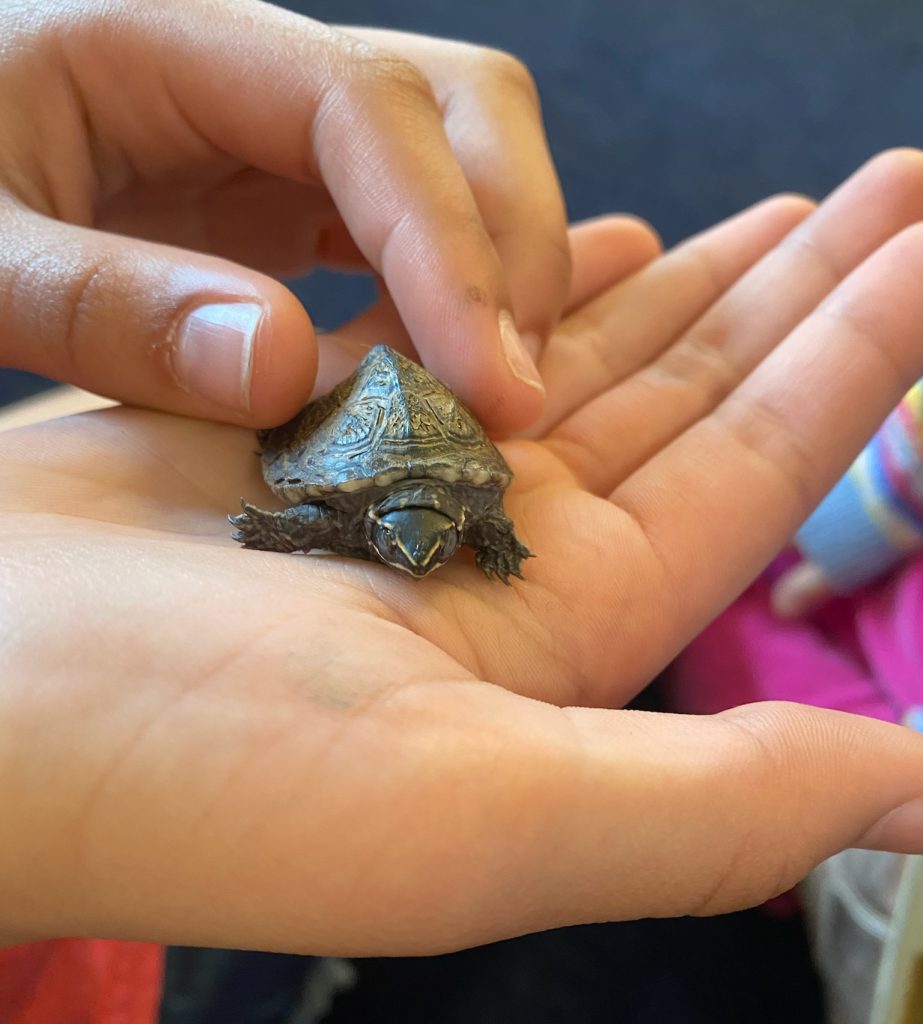The Montessori Children’s House Elementary program offers students the opportunity to learn and develop skills that will be used throughout their academic and professional life. The elementary curriculum was designed to develop critical thinking, foster self-management, and cultivate independence.
The Elementary program is a mixed-age classroom for children aged six to nine. Children who are entering the Lower Elementary are beginning their ‘second plane of development.’ This stage can often be characterized by children’s endless curiosity and passion for hands-on exploratory research. During their second plane of development, children start to develop their abilities to reason and understand abstract concepts.

Our program is characterized by an emphasis on self-directed inquiry, immersion in a prepared environment to foster learning, and the use of self-correcting materials that introduce concepts concretely. Each day students create their own schedules, which include daily math, reading, language arts, and cultural studies. A two to three hour concentrated work period offers students the flexibility to manage and complete work at their own pace. Children learn to initiate, choose, and complete work independently.
In an elementary classroom, students are guided by teachers who closely observe each student’s progress, teach individual and group lessons, assist in creating personal work plans, and offer students support that is non-intrusive, but fosters self-discovery. Ultimately, children progress from a variety of concrete experiences and move to an abstract awareness that fosters independence and a confidence that demands academic excellence.

Language Arts
The study of language arts is fully integrated across all aspects of the learning environment. Speaking articulately, writing with clarity, and reading with fluency are important goals of the language curriculum. In reading, students continue to work on decoding and fluency, semantics and syntax, vocabulary, literature and research skills and participate in Literature Circles. Writing focuses on the writing process, composing words, paragraphs, and essays, the mechanics of handwriting, cursive writing, keyboarding, punctuation, and spelling. Grammar studies include learning the parts of speech, sentence analysis, and advanced verb conjugation. Language lessons provide the fundamental building blocks for all future learning.
Math
The Lower Elementary math curriculum deepens the student’s understanding of simple mathematical operations that were first introduced in the Primary classroom. The Lower Elementary program offers a continuum of Montessori materials designed to provide a solid foundation for learning, understanding, and mastering basic operations, as well as more abstract concepts such as algebra and geometry. Students develop a conceptual understanding of number facts and functions, the value of money, the meaning of time and spatial relationships, as well as computational and problem solving skills.
Although traditionally, the study of geometry is undertaken in later years as an abstract series of rules, theorems, and propositions, Dr. Montessori saw geometry as firmly rooted in reality and built a curriculum that uses concrete, sensorial experimentation, leading students to concepts through their own creative research. The point of the work is not so much determined by the result, but by all the work the child has done to reach that result. The essence is in the journey, not in the destination.

Cultural Studies
Cultural Studies in the Lower Elementary encompass zoology, botany, geography, history, earth sciences, and ecology. The curriculum is a rich part of every Montessori classroom, where students are first introduced to the “Five Great Lessons”. These lessons are presented with impressionistic stories and materials, offering children a panoramic view of the universe and a sense of how humanity spans across time. Through the initiation of the Great Lessons, many science and history concepts are explored, presented, and researched to further engage and encourage students to seek out their own individual interests. This broad scope of topics appeal to students in a manner that capitalizes on their interests and learning styles.
Cosmic Education
Cosmic education is the path through which children develop a global vision of the world in which they live. Through Cosmic Education, students develop an understanding of the interdependence of all living things. The Montessori elementary curriculum teaches children that all living things cannot be separated and may only exist in the presence of each other. It is within the context of Cosmic Education that the children begin to conceptualize an appreciation and awareness for the inter-relatedness of all living things.
The theme of Cosmic Education is best summed up in the following quotation from Dr. Montessori:
“The child will develop a kind of philosophy which teaches this unity of the universe; this is the very thing to motivate his interest and to give him a better insight into his own place and task in the world and at the same time presenting a chance for the development of his creative energy.”
The Lower Elementary curriculum integrates all subjects in a way that evokes the imagination of the child. The presentation of all lessons are given as part of a large-scale narrative that presents the theories of the earth, life, human communities, and modern history, always in the context of the wholeness of life. The children begin to see connections more clearly, and ultimately develop a concrete understanding of our complex world and their own role in a global capacity.



